Redeemer is a project about creating awareness about medical emergency responses amongst the masses. It engages with the volunteers who willingly come forward to help road accident victims, empowers them through education and hands-on live demonstration through workshops.
Brief:
To devise a service or a tool which aims to help the road accident victims. It should facilitate a faster medical assistance focussing the urban areas of India.
Why is such a project required?
With 15 fatalities every hour, India has the highest number of road accident deaths in the world. Of those injured in accidents almost 80% victims do not achieve access to any care within the Golden Hour, which is the most crucial time after an accident. According to 201st report of the Law Commission of India, over 50% can be saved if even basic emergency care can be made available in this time. The main reason why most victims are unable to access care is the missing emergency medical services (EMS) system in most parts of the country.
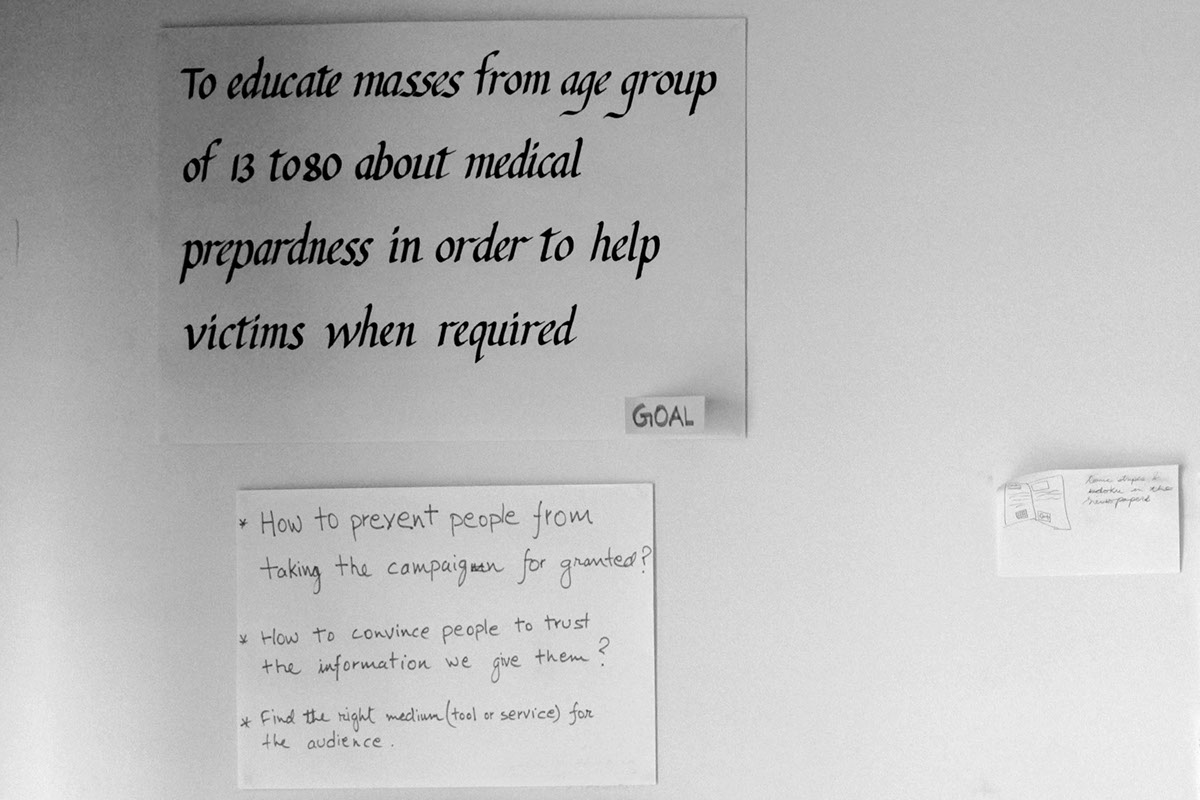
At the beginning of the project, I set a goal and some questions to prevent this project from failing.
Interviews:
In order to understand the perception of the general masses, I set out to seek their experiences with road accidents. The interviews varied with each one narrating their personal accidents experiences which occurred at different surroundings due to various circumstances. This helped me understand the possible scenarios of accidents and gave me clarity about the extent to which the solution should offer. Following this, I extracted quotes which could provide me with insights. The quote were further categorised to detect patterns and understand the primary causes of concern.

The main points from the interviews.

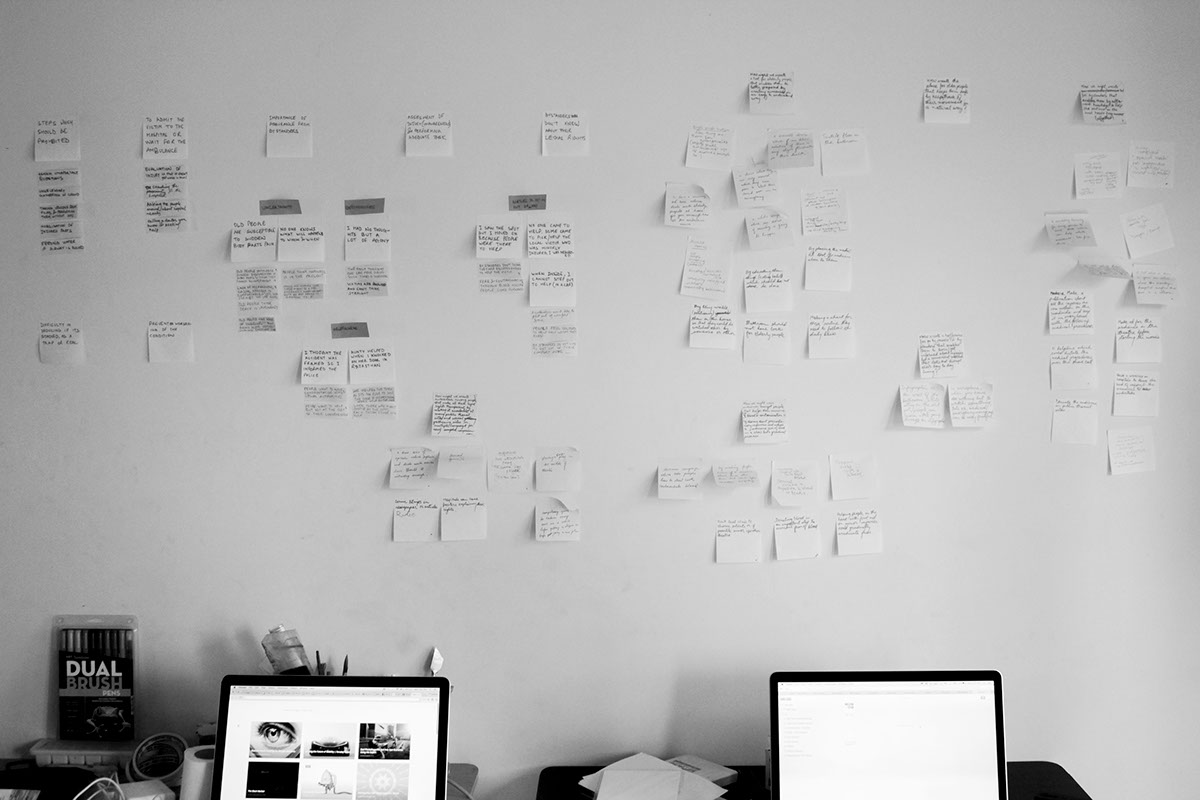
Quotes and insights from the interviews.
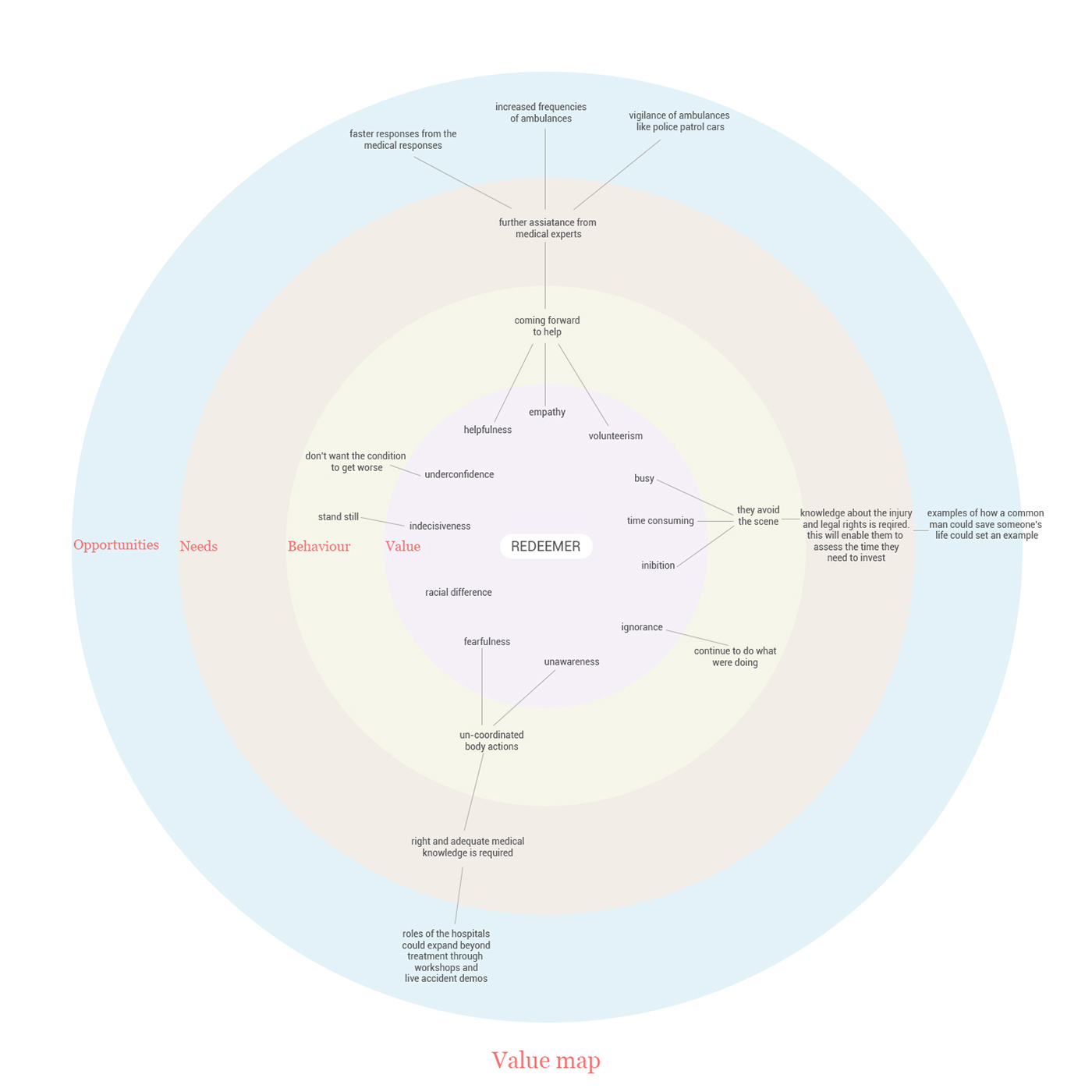
Following the extraction of insights, I framed questions around them that could lead to solutions. The questions are called "How might we" or "HMW". The solutions aspire to be radical, creative and responsible.
Design challenges:
– HMW create a tool for bystanders that enables them to provide emergency medical response to road accident victims by guiding them in real-time in an accessible way?
– HMW create a service that brings emergency medical response to accident victims before the ambulance arrives by tapping into the medical resources available in their vicinity, quickly?
– HMW create a basic training program for medical emergencies that inculcates life saving skills, create empathy and builds confidence to come forward when the need arises in an easy to take up way?
Solution Ideas:
Along with friends Akshay and Anwesha, we created around 70 ideas for the initial 5 HMWs. We decided to distill down to 3 HMWs as the other two went beyond the scope of the project and had the potential to become a project in themselves. On completion, we took votes through discussion and critique of the ideas based on credibility, feasibility and alignment to the goal of the project.

Ideas sketched and explained in few words.






From the pool of ideas, few were selected specific to the problem and were prioritised. Since India varies with demographic, culturally and class, devising a set of deliverables was important. I decided to keep the urban audience in mind to start of with.
Concept:
A platform that brings together a community of local doctors and laymen who connect with each other, train each other and volunteer to provide emergency medical response to road accident victims when called upon.
The platform comprises of an app that lets people connect with other volunteers and sign up for and host training and meetups by revealing a real time network of volunteers, events and emergencies in a way that sensitises people and evokes their sense of duty. This network of good Samaritans thrive on a sense of duty to help, and the respect, satisfaction and meaning it adds to their lives.
Storyboard:
In order to visualise how the app could cover the scenarios, I made few storyboards. This helped me to weed out the loopholes and minute details which could have been easily missed out.
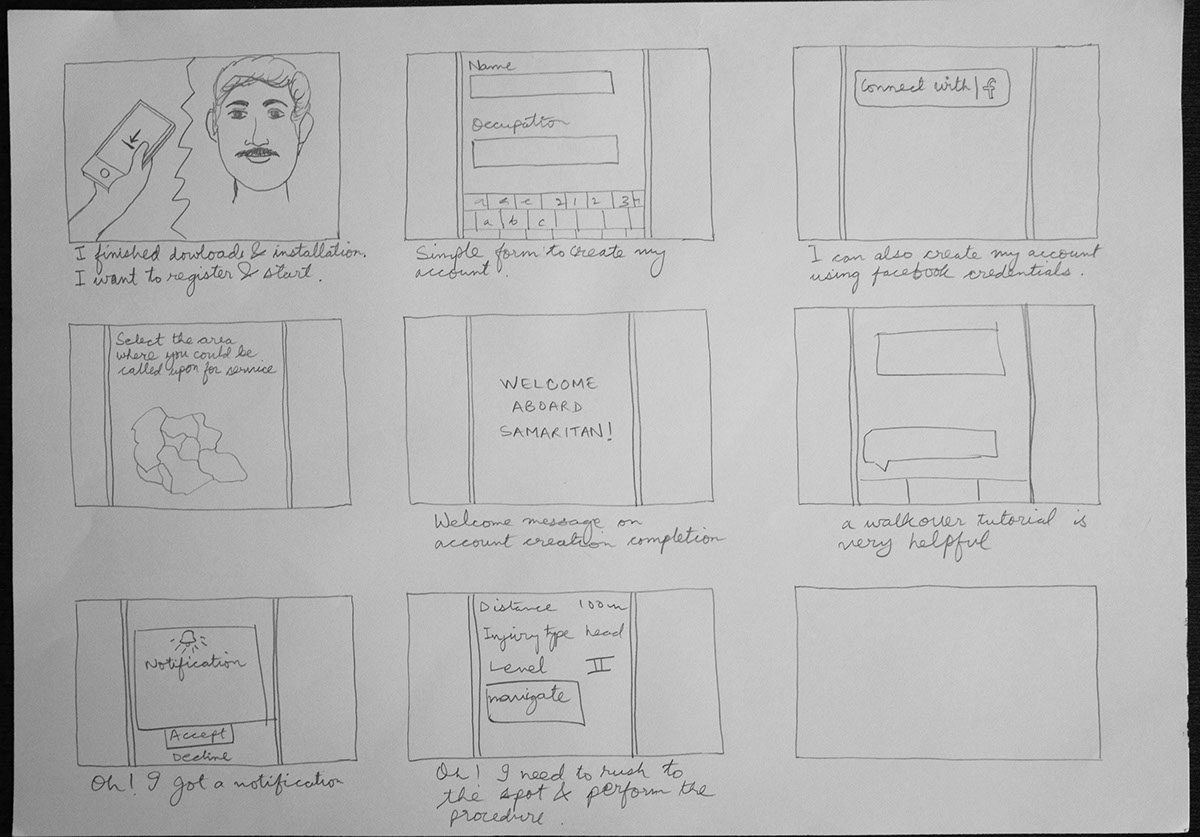


The above three storyboards cover onboarding, workshops and incentive scenarios.
Through conversations with people, a strange finding came about. Since people are mostly occupied with some other activity, they do not like to intervene in any other matter unless they see any benefit out of it. Though this app is intended for people who are self-driven to make a change, it also comes with some incentives. Below is a mind map to figure out how the volunteers could be given incentives.


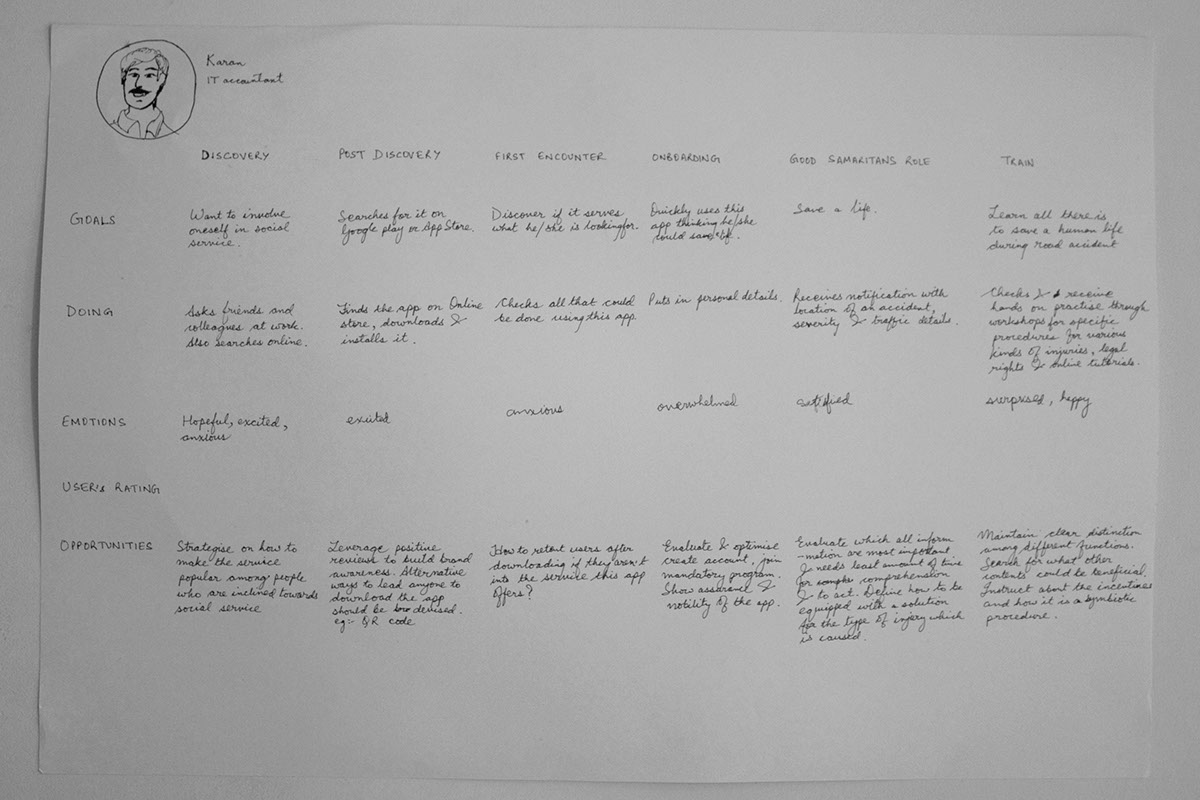
User journey map enabled me to establish a desired experience from the time of downloading to performing a function.
Testing
The user testing involved three iterations of the concept and involved feedbacks which were incorporated. The final version was tested on 1. untrained volunteer, 2. trained volunteer (a doctor). The learnings from each were noted after showing a video of a road accident and their response to the situation.







Wire flows of the app. These are different flows in the app which an user will cover to reach his/her goal.
Visual Design:
Below are the final screens of the app which covers all the functionalities and are categorised by different scenarios. I have used material design guidelines for colour palette, typography and layout.
Splash screen and app introduction




User onboarding



Live feed and live accident reporting



Training section





Inside screens for workshops and medical procedures


Prototype
Reflection:
This project was conceived due to few personal incidents which I had experienced. I do not wish to describe them in details but it left me wondering that my presence in the vicinity of the victim was of no use. I did not know any medical procedure. The ambulance came and did its job but only after half an hour had elapsed. The biggest learning which I drew from reaching this far is that people need to be shaken out of their apathy. Realisation about how important life saving skills are should be harnessed. This project gave me opportunity to interact with ambulance drivers, doctors and common people who ranged from teens to olds. An app cannot solve this pressing issue but can throw light in the right direction. Media like PSA, publications, posters, newspapers can be targeted to reach a wider range of audience covering rural and remote areas. Most importantly the key resides in the mind of the people who want to be responsible and take responsibility of the situations.



